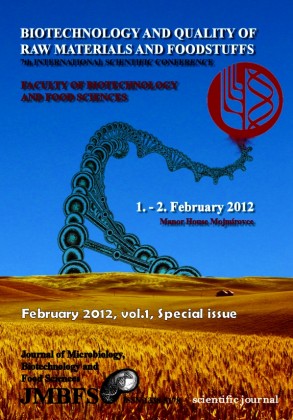HEAVY METALS IN MIDDLE NITRA RIVERSIDE
Keywords:
Nitra river, heavy metals, soil contamination, pollutionAbstract
Present state of environment is widely affected by various impacts of man which significantly eliminate negative affecting of its influence on the environment. In the past this fact was not so implemented and thus there was uncontrolled escape of contaminants of organic, but also inorganic origin into various components of environment. The most sensitive component is water ecosystem and its close plates (base sediments, banks sediments and biosphere near the flows).River Nitra ranks among the most affected water ecosystems in SR that was in 1965 the recipient of sludge, that was by accident in Zemianske Kostoľany uncontrolled spilled into the river with aftermath of long-term contamination of all sub-components in ecosystem, mainly by heavy metals (Hg, As, Pb, etc.).
Soil contamination by Cd and Hg was analytically confirmed. The contents of these risk elements in soil extract of aqua regia 1.85 - 3.7 fold (Cd) and 4.57- 36.3 fold (Hg) exceeded the limit values (0.4 mg.kg-1 and 0.15 mg.kg-1 respectively) given by the legislative. Other metals exceeding limit values were lead (1.064 - 1.072 fold), zinc (1.096 - 1.192 fold) and chromium (1.172 – 1.644 fold).
From assessed soil content of heavy metals only bioavailable forms of Pb determined in soil extract by NH4NO3 2.0 - 3.3 fold exceeded the limit value 0.1 mg.kg-1.
Downloads
Download data is not yet available.
Downloads
Published
2012-02-01
How to Cite
StanoviÄ, R., Ãrvay, J., Vollmannová, A., & Čéryová, S. (2012). HEAVY METALS IN MIDDLE NITRA RIVERSIDE . Journal of Microbiology, Biotechnology and Food Sciences, 1(Special issue), 806–812. Retrieved from https://office2.jmbfs.org/index.php/JMBFS/article/view/7417
Issue
Section
Other
License
Copyright (c) 2012 Radovan StanoviÄ, Július Ãrvay, Alena Vollmannová, Silvia Čéryová

This work is licensed under a Creative Commons Attribution 4.0 International License.
All papers published in the Journal of Microbiology, Biotechnology and Food Sciences are published under a CC-BY licence (CC-BY 4.0). Published materials can be shared (copy and redistribute the material in any medium or format) and adapted (remix, transform, and build upon the material for any purpose, even commercially) with specifying the author(s).

